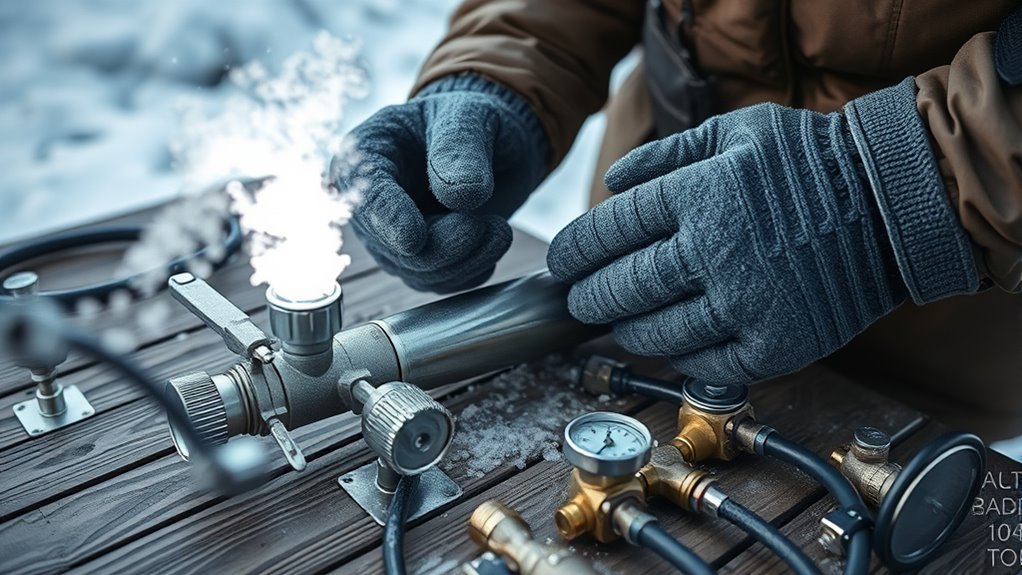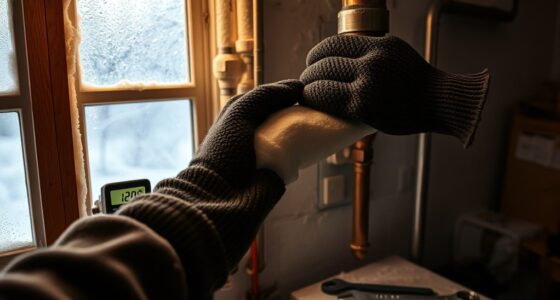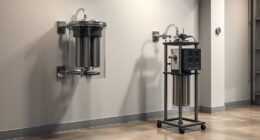To go from zero to confident in winterizing your water system, start by understanding key terms like pipe insulation, drain valves, antifreeze, and exterior faucet covers. Learn their roles in protecting against freezing and leaks. Gather supplies such as insulation, tools, and antifreeze. Follow step-by-step procedures like shutting off water, draining pipes, and insulating vulnerable areas. If you keep exploring, you’ll master each step and make certain your system stays safe all winter long.
Key Takeaways
- Understand essential terms like pipe insulation, drain valves, antifreeze, and freeze protection to navigate winterization confidently.
- Learn definitions of system components such as pumps, faucets, and valves, including their roles in winter protection.
- Familiarize with tools like wrenches, sprayers, and waterproof tape used during the winterizing process.
- Know key procedures like draining systems, insulating pipes, and shutting off water supplies for effective winterization.
- Recognize common issues like frozen pipes and leaks, along with troubleshooting terms to maintain system integrity.
Understanding the Basics of Water System Winterization
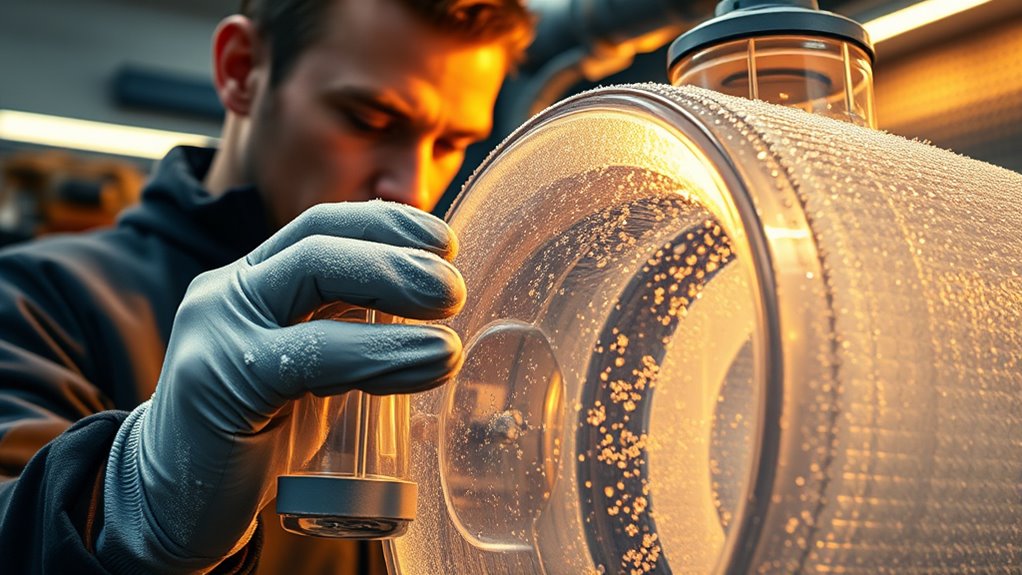
Before winter hits, understanding the basics of water system winterization is vital. You need to guarantee your system maintains pumping efficiency and water quality during the cold months. Proper winterization prevents pipes from freezing and bursting, which can cause costly damage. Start by draining or insulating pipes and tanks to reduce the risk of freezing. Check that your pump operates efficiently by inspecting for any leaks or blockages, as these can impair performance. Maintaining water quality is also essential; consider adding antifreeze or using water treatment solutions to prevent corrosion and bacterial growth. Additionally, ensuring your system has proper insulation helps retain heat and protects against cold damage. These steps help your system run smoothly and reliably throughout winter. Being proactive now saves you time, money, and headaches once temperatures drop.
Key Components and Their Roles in Winter Protection

Understanding the key components of your water system is essential for effective winter protection. These parts work together to prevent freezing and damage. Pipe insulation wraps pipes to retain heat and prevent freezing. Valve protection shields critical valves from cold air, reducing the risk of burst pipes. Properly insulating and protecting these components keeps your system functional during winter. Here’s a quick overview:
| Component | Role |
|---|---|
| Pipe insulation | Keeps water in pipes from freezing by retaining heat |
| Valve protection | Shields valves from cold air, preventing freezing and damage |
| Drain valves | Allows draining of water to avoid freezing buildup |
| Exterior faucets | Insulated or shut off to prevent freezing |
Ensuring these components are properly protected minimizes winter risks and keeps your water system running smoothly. Additionally, cultivating a creative practice can foster problem-solving skills useful in winterizing projects.
Essential Tools and Supplies for Winterizing

To effectively winterize your water system, you’ll need a selection of essential tools and supplies that make the process easier and more reliable. First, gather pipe insulation to protect exposed pipes from freezing. You’ll also need outdoor faucet covers to shield outdoor faucets from cold damage. A wrench is useful for disconnecting hoses and shutting off valves. A garden sprayer filled with non-toxic antifreeze helps clear water from traps and lines. Finally, have waterproof tape on hand for sealing leaks or securing insulation. Utilizing GMC tuning techniques can help optimize your system’s performance and prevent issues caused by cold weather.
Step-by-Step Procedures for Winterizing Your Water System

Begin by turning off the main water supply to prevent additional water from entering the system. Next, open the drain valve to release any remaining water from pipes and fixtures. Be sure to drain all faucets, toilets, and appliances connected to the water system. Once drained, insulate exposed pipes with pipe insulation to prevent freezing. Check that the drain valve is fully open to ensure complete drainage. If you have a water heater, follow manufacturer instructions to drain it safely. Consider blowing out remaining water with compressed air if necessary. Confirm all valves are closed after draining. Properly insulating and draining your system minimizes freeze damage and prepares it for winter. Additionally, implementing Kia Tuning techniques can optimize your vehicle’s performance during cold weather months. This straightforward process helps keep your water system safe and functional during cold months.
Common Issues and Troubleshooting Tips
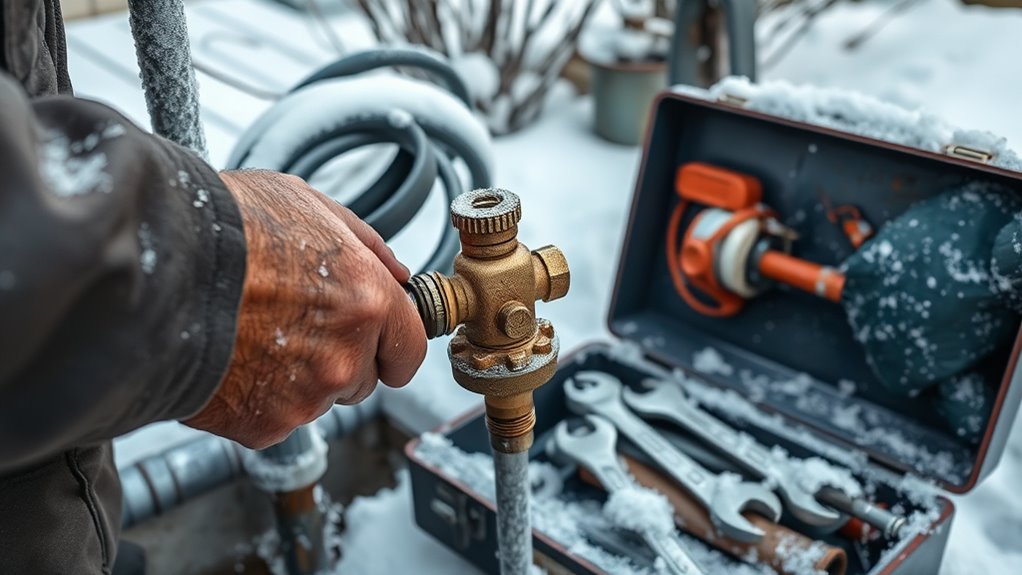
Frozen pipes are a common winter issue, but you can prevent them by insulating vulnerable areas and keeping the heat on. If you notice leaks, quick detection is key—look for drips, cracks, or damp spots around fittings and joints. Address problems promptly to avoid costly repairs and keep your water system running smoothly all winter.
Frozen Pipes Prevention
Are your pipes at risk of freezing during the cold months? To prevent this, focus on key measures like pipe insulation and outdoor faucet covers. Proper pipe insulation keeps the warmth in, especially around vulnerable areas. Installing outdoor faucet covers adds an extra layer of protection against freezing temperatures. You should also:
- Insulate exposed pipes in unheated areas
- Keep interior cabinet doors open to circulate warm air
- Drip faucets slightly to prevent pressure buildup
- Seal gaps around pipes and vents
- Drain outdoor hoses and shut off water supply to exterior lines
- Regularly check for filtration systems and ensure they are functioning properly to prevent debris buildup that can cause blockages and freezing issues
These steps help maintain consistent temperatures and reduce the chance of pipes freezing and bursting. Regularly inspecting and maintaining these protections ensures your water system stays functional throughout winter.
Leakage Detection Techniques
Detecting leaks early can save you time, money, and prevent water damage. One effective method is acoustic leak detection, which involves placing sensors at strategic points along your pipes. Proper sensor placement is vital; position them near joints, valves, or areas with suspected issues. Listen for the distinct hissing or dripping sounds that indicate a leak. Acoustic detection devices amplify these noises, making leaks easier to identify even in hidden sections. Regularly check sensor connections and make sure they’re securely attached for accurate readings. If you notice unusual sounds or increased water bills, use acoustic leak detection to confirm leaks before digging. This proactive approach helps you catch problems early, minimizing repairs and water waste. Incorporating tuning techniques can also improve the overall efficiency of your water system, reducing the likelihood of leaks caused by pressure fluctuations or system stress.
Post-Winter System Checks and Maintenance
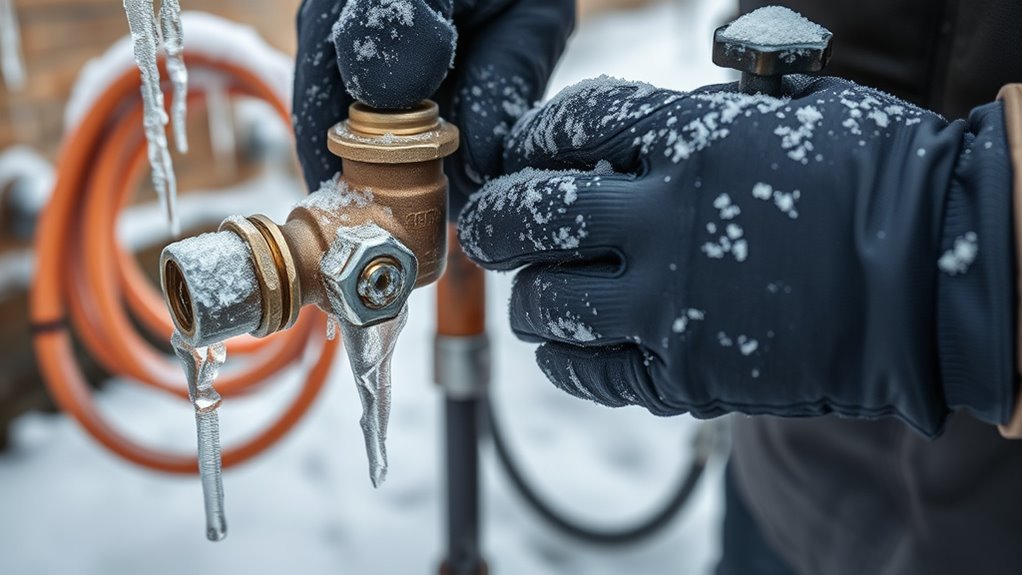
Once winter has passed and temperatures rise, it’s crucial to perform thorough checks on your water system to verify it’s ready for regular use. Start by inspecting for any signs of damage or leaks. Check the backflow prevention device to ensure it’s functioning properly, preventing contamination. Test your water pressure to confirm it remains within ideal levels, avoiding potential damage to pipes and fixtures. Also, flush out any sediment that may have accumulated during winter. Examine hoses, valves, and fittings for cracks or blockages. Finally, turn on your system gradually to observe how it responds under normal operation. A quick, all-encompassing review now helps prevent issues later and guarantees your water system is safe and efficient for the seasons ahead. Additionally, consider inspecting water quality components to ensure filters and media are functioning effectively after winter.
Frequently Asked Questions
How Often Should I Winterize My Water System?
You should winterize your water system every fall before temperatures drop below freezing. Regular seasonal maintenance helps prevent damage from frozen pipes and extends your system’s longevity. If you experience frequent cold snaps or live in an area with unpredictable weather, consider winterizing more often. Staying proactive guarantees your system remains protected, minimizes costly repairs, and keeps everything running smoothly year after year.
Can I Winterize My Water System Myself or Hire a Professional?
You can definitely winterize your water system yourself with some DIY tips, but hiring professional services guarantees everything’s done correctly and safely. If you’re comfortable with plumbing tasks and follow detailed instructions, DIY is a great option to save money. However, if your system is complex or you’re unsure, it’s wise to call in experts. Professionals have the experience to prevent potential damage and give you peace of mind.
What Are Signs My Water System Needs Winter Protection?
You might notice your water system needs winter protection if you see pipes sweating, cracking, or freezing during cold snaps. Pay close attention to exposed pipes and areas with inadequate insulation. To prevent freeze damage, guarantee proper pipe insulation and consider additional freeze prevention measures. Acting early can save you from costly repairs later. Don’t wait for trouble—winterize now to keep your water flowing smoothly all season long.
How Long Does the Winterization Process Typically Take?
The winterization process typically takes about 2 to 4 hours, depending on your system’s size and complexity. Your process timeline includes draining the water, adding antifreeze, and insulating pipes. You should allocate enough time to complete each step thoroughly, especially if you’re unfamiliar with the procedure. Rushing could leave water in the system and cause damage, so plan accordingly to make sure your water system stays protected throughout winter.
Are There Environmentally Friendly Winterization Options Available?
Yes, eco-friendly options are available for winterizing your water system. You can use biodegradable solutions that safeguard pipes without harming the environment. Look for environmentally conscious antifreeze or non-toxic, biodegradable solutions designed specifically for plumbing. These options help prevent damage during winter while reducing your ecological impact. By choosing eco-friendly winterization products, you guarantee your system stays protected and contribute to a healthier planet.
Conclusion
Winterizing your water system is like wrapping a delicate gift in a sturdy, frost-proof blanket—protecting it from the harshest cold. With careful steps and the right tools, you’ll guard your system against icy damage, ensuring it wakes up healthy and ready when spring whispers its arrival. Think of it as tending to a dormant garden, patiently shielding your investment until the warmth returns, so your water flows freely and confidently once again.
